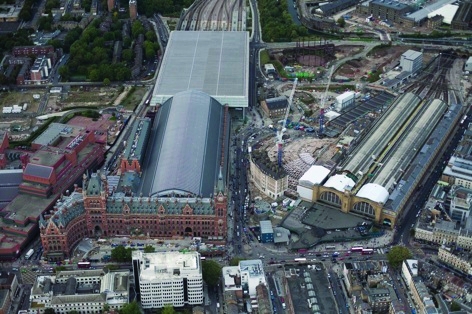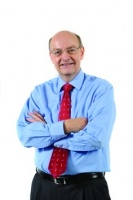The headquarters of the Institution of Civil Engineers is imposing with a capital I. Barely yards from Parliament Square and facing the Treasury across the road, its exterior has the Portland stone portico and columns of London’s most serious public buildings.
Inside, the expansive, wood-panelled reception area is lit by a lofty, glazed cupola, illuminating the portraits of eminent engineers and pictures of the great and iconic feats of past and present engineering. A blue plaque sits over the reception desk, declaring that Thomas Telford lived here.
It’s enough to make any engineer feel the weight of history. Peter Hansford, the institution’s new president, certainly feels the need to make the present rather more present.
’I’ve only been in this office for four days,’ he said, stepping out from behind his mahogany desk and into the large room where paintings of the SS Great Eastern and the Clifton Suspension Bridge face each other on opposite walls.
’I’m going to put some new pictures up of modern civil engineering; High Speed One, the Channel Tunnel Rail Link; Crossrail; and possibly some offshore wind turbines. There are heaps of areas of innovation in civil engineering; it’s a very exciting time.’

Hansford, whose career has been spent mainly in rail engineering, can’t help but acknowledge the heritage of the profession. ’We are the oldest branch of engineering and there is a traditional connotation to that. You get a feel for that when you enter this building. Civil engineering does take a long time to change.’
The perception that civil engineering is largely unchanged from the golden days of the Victorian era is a long way from the truth, however. ’It’s certainly not true that we’re building things the same way as we did in Brunel’s day. The industry has moved on and it must move on at a rapid pace.’
The urgency stems from the need to reduce carbon emissions, with the government committed to a target of cutting emissions to 20 per cent

of 1990 levels by 2050. ’That is not incremental change; it’s a massive, massive step change,’ Hansford said.
The only way we’re going to get there is by doing things very differently: different forms of infrastructure, different materials, construction methods, ways of appraising projects. That’s going to need significant innovation and civil engineering is right at the centre of all that.’
Hansford believes that civil engineering - indeed, any engineering discipline - can no longer be compartmentalised. ’Engineering is very multidisciplinary, but in my experience civil engineers are very often the integrators on projects.
I’m not trying to score points against the other disciplines, but it might be because civil engineers have to deal with a wider stakeholder element, to do with the environment in which projects take place, while the other branches are more focused on the technology.’
Civil engineering projects tend to have long lead times in the planning, design and development phases but, two years after the Climate Change Act that enshrined the 2050 targets in legislation, Hansford thinks that the first elements of the changes that will help the UK on the way to those targets are already visible.
’The major changes are in power generation and transport,’ he said. ’We’re seeing the big push to new nuclear power, but that’s only part of the mix - we’re also seeing the planning phases of the big offshore wind farms.
The other change we’re seeing is in rail, where we’re starting out on the High Speed Two line, to increase capacity between London and Birmingham, and take the pressure off the West Coast Mainline.
Providing the power for that is generated in a green way - which is the intent - it’ll make a big difference to the carbon consumed for that journey.’
However, there is much further to go and Hansford is unconvinced that the government is providing the drive he feels is necessary to push carbon reduction forward. ’It’s the government’s role to own the implementation of carbon reduction,’ he said.
The way you drive change is to have a champion - and in this case it has to be a political champion; governance, in the form of a structure to oversee the initiatives that are needed to make the changes happen; and you need real projects - large-scale schemes - to achieve reduction in those areas. I think these structures are emerging, but I’m not seeing it strongly enough.’
The ICE has been closely involved with government and Hansford pointed out that his first meeting as president was with Paul Morrell, the government’s chief construction adviser, to discuss one of the key themes of his presidency year - a ’Low Carbon Routemap to 2050’ that will outline the steps industry has to take to ensure the emissions targets are met.
This will include a panel to assess the carbon efficiency of construction processes and devise ways to evaluate projects based on their lifetime carbon emissions.
’We just don’t have a choice about low carbon,’ Hansford said. ’Of course, there will always be pockets of people who think there’s no need for this and it’s not our role to control what people think. But, in the last two years or so, I think we’ve gone beyond the situation where people are thinking about reductions because legislation says they have to. There’s a very big groundswell in the profession towards this being the right thing to do - the sustainable way forward for infrastructure around the globe.’

Peter Hansford
President, Institution of Civil Engineers
Education
1972 BEng in civil engineering from Nottingham University
Peter also holds an MBA from Cranfield School of Management
Career
Began with Amey Roadstone Construction, before a spell with Maunsell Consultants in Hong Kong
1986 Joined Nichols, London, as a consultant; worked as engineering manager for Docklands Light Railway City extension and project manager for DLR Beckton extension
1996 Managing director at Nichols;
present executive director at Nichols
2000-2 Executive director of infrastructure at Strategic Rail Authority
2003-4 Partner at Gardiner and Theobald
Peter’s work has included strategic reviews for the Scottish Parliament building, the Highways Agency’s major roads programme, the Nuclear Decommissioning Authority’s capital projects portfolio, and numerous rail and power-station projects
Peter joined the ICE council in 2000, where he has held a variety of posts
Q&A Building bridges
You’ve made attracting young people into engineering a focus of your presidency year. How will you approach this?
We wanted to focus on 12-13 year olds this year, because we want to enthuse them about engineering before their GCSE choices are made. This isn’t just about raising the awareness of engineering with children. Just as importantly, we’re addressing parents and teachers - many of whom don’t know what engineers do. We’re all influenced by teachers to some extent and it’s important that they realise the role of engineering.
This has been tried before. What new ideas do you have?
Something we thought would enthuse that age group is to tie it in with sport, so we’ve created the Create Sport Challenge. Schools throughout the country will be able to enter a team that will have from January to Easter to create a design for a sports venue that considers engineering issues, planning, materials, environment, transport and so on. An ambassador - one of our members - will visit each school to help pupils understand the issues and the teams will produce a design and a model. There will be prizes and it’ll be fun, but the real thing is to create awareness of engineering.
Do you think civil engineering needs a visible champion to help with that?
It’s true that civil engineering doesn’t have the same limelight that architecture has. Civil engineering underpins things, rather than being what people look at - it’s hidden behind the architecture. Bridges might be an exception to that.
But people still tend to think of Norman Foster as a bridge builder, although he’s an architect - Brunel built bridges and he was an engineer.
Maybe it’s something to do with the psyche of civil engineers - we’re not looking to be the front people and we’re not looking to steal the limelight. I think we’re looking to ensure that we support and encourage the development of the sort of infrastructure the country really needs. A lot of the time, because civil engineering is mostly hidden, you only think about it when it goes wrong - when there’s flooding or there’s a need for road maintenance.
Figures such as Brian Cox and Jim al-Khalili have done wonders for physics and science in general. Do you need a media figure?
I think we do need someone visible. We need to find some media stars.





Swiss geoengineering start-up targets methane removal
No mention whatsoever about the effect of increased methane levels/iron chloride in the ocean on the pH and chemical properties of the ocean - are we...